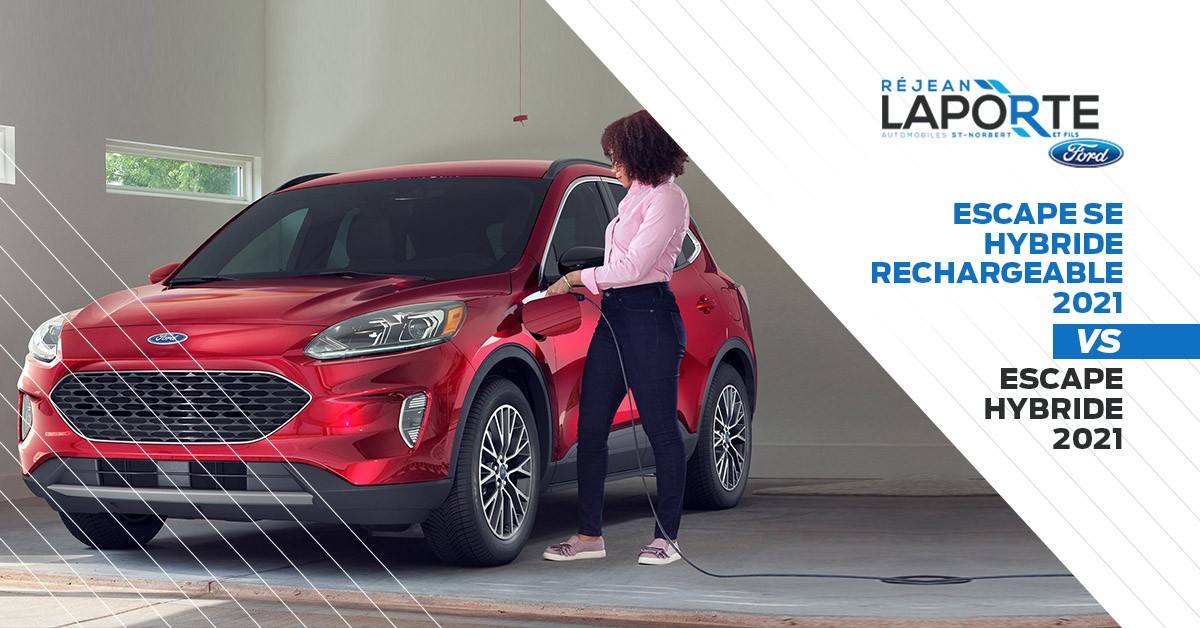Ford has completely redesigned its Escape compact SUV for the fall of 2019. At the time of the launch, the regular version of the model as well as the hybrid variant had been presented. We were then promised the eventual arrival of the plug-in hybrid (PHEV) variant.
We finally have a choice between the Ford Escape Hybrid and the Ford Escape Plug-in Hybrid. And what is the difference between the two? Minimal and major at the same time. Your Réjean Laporte et Fils dealership in Saint-Norbert in Lanaudière, near Saint-Gabriel-de-Brandon, Saint-Jean-de-Matha, Berthierville and a few minutes from Joliette, presents its Ford sport utility vehicles for sale.
The mechanics
First of all, let's settle the question concerning the traditional mechanics that serve both versions. We're talking about a 2.5-liter naturally-aspirated 4-cylinder engine. The latter is combined with a continuously variable transmission (CVT), responsible for distributing power to the front wheels. An electric motor supports the gasoline block.
The difference lies in the capacity of the battery. With the rechargeable model, it is 13 times larger than with the traditional hybrid version. In fact, it is 1.1 kWh with the latter and 14.4 kWh with the model equipped with a charging cable.
All this means that on the road, the Ford Escape Plug-In Hybrid offers an all-electric range of 60 kilometers. Charging time is estimated at about 3.5 hours at a Level 2 station, which is a 240V outlet.
On the road: electric driving
With the Ford Escape Hybrid, there's no electric range, except for short bursts of driving when the battery is at full capacity. It also regenerates itself when braking, so you can enjoy a few electric moments behind the wheel.
As a result, the average fuel consumption rating is 5.4 L/100 km in the city and 6.3 L/100 km on the highway, all for a combined fuel consumption of 5.8 L/100 km. Frankly, that's excellent.
With the PHEV variant, it varies, of course, depending on the discipline of recharging after each trip, but also on the type of trip you make. Someone who drives an average of 50 km a day will hardly ever use gas. Someone who drives 100 km a day will use traditional mechanics 40% of the time.
In terms of behavior, the differences are not huge. The Esacape Plug-In Hybrid is slightly more powerful, with 221 horsepower versus 200. Otherwise, the electrified Escape offers solid performance, as does the entire lineup. By far here, Ford has delivered the best Escape to date with the current-generation model.
The versions
The beauty of these two models is that there's no penalty for choosing one or the other. In fact, there are three versions of each, so there is plenty of choice. Thus, both the Ford Escape Hybrid and the Ford Escape Plug-In Hybrid are marketed in SE, SEL and Titanium configurations.
With the first proposal, you get the basics, including heated front seats and integrated connectivity for Apple CarPlay and Android Auto apps. In the mid-range, you get conveniences like a heated steering wheel and a power liftgate. Finally, with the Titanium variants, Ford serves up an all-inclusive package that includes a Bang & Olufsen audio system, voice-activated navigation, and a digital display instrument cluster, among other things.
The best choice?
There's no better choice between the hybrid and plug-in hybrid versions of the Ford Escape. In fact, it all depends on your needs and habits. There is a few thousand dollars difference between the variants of each model, a difference that is reduced with government rebates. It is also important to make your calculations according to the use you intend to make of the vehicle. Réjean Laporte et Fils is waiting to help you make a choice.
Ford Escape hybride rechargeable 2021 vs Ford Escape hybride 2021
